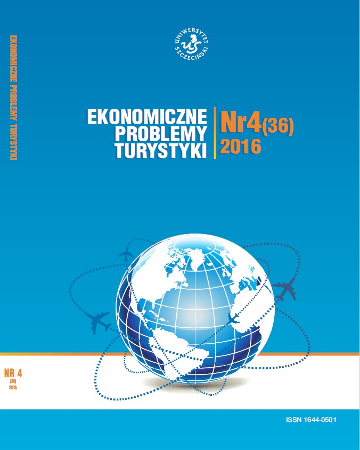
ISSN: 1644-0501
eISSN: 2353-3188
OAI



Issue archive /
nr 1 (29) 2015
Dopasowanie produktów turystycznych do potencjalnych oczekiwań turystów na przykładzie Puerto de la Cruz na Teneryfie
(Adjusting Tourist Products Towards Tourist Expectations Using the Example of Puerto De La Cruz in Tenerife)
| Authors: |
Eleonora
Gonda-Soroczyńska
Uniwersytet Przyrodniczy we Wrocławiu |
| Keywords: | tourist product tourist town Puerto de la Cruz public place urbanist floor |
| Data publikacji całości: | 2015 |
| Page range: | 27 (195-221) |
Abstract
The focus of the study is directed towards the tourist product – which, among others, includes the urbanist element that is the so-called urbanist floor – in the tourist town of Puerto de la Cruz in Tenerife. The unique spatial development of this Canarian resort is important, especially in the context of the maximum utilisation of the soil for the purposes related to the tourist function, as it is an extraordinary area, where the tourist function is dominant. The studied area has immense tourist potential (i.e. the climate, the weather, the tourist infrastructure, the landscape). Undeveloped terrain and areas surrounded by developed terrain and functioning as tourist movement locations are arranged in a specific, perfectly harmonious manner. These include so-called open public spaces, where the different types of urbanist floors have been implemented with the use of a diverse source of materials and in a very sensible, apt way, showing great taste in the domain of architecture, urbanism and planning. The study serves as an answer to the question: “Can an urbanist floor influence the quality of functioning of a tourist town and is it a significant tourist product?”.
Download file
Article file
Bibliography
| 1. | Altkorn J., Marketing w turystyce, PWN, Warszawa 1995. |
| 2. | Borowski B., Bourmer A., Fründt H.-J., Tenerifa, Verlag Karl Baedeker, Aulage 2005. |
| 3. | Borzyszkowski J., Markowe produkty turystyczne i ich związek ze strukturą ruchu turystycznego – przykład Czech, Polski, Słowacji i Węgier, w: Popyt turystyczny. Zagadnienia podstawowe, „Zeszyty Naukowe Uniwersytetu Szczecińskiego” 2012, nr 697, „Ekonomiczne Problemy Usług” nr 82. |
| 4. | Gaworecki W.W., Turystyka, PWE, Warszawa 2003. |
| 5. | Hernández C.C., Morales F.C., Museo de Arte Contenporáneo Eduardo Westerdahl, Instituto de Estudios de Canrias 2010. |
| 6. | Jankowska A., Adamczak S., Teneryfa, Wyd. Gauss, Bielsko-Biała 2012. |
| 7. | Kotler Ph., Marketing. Analiza, planowanie, wdrażanie, kontrola, Gebether i S-ka, Warszawa 1994. |
| 8. | Kotler Ph., Marketing Menegement, Prentice Hall, Inc., Englewood-Cliffs, New Jersey 1980. |
| 9. | Kurek W., Turystyka, PWN, Warszawa 2008. |
| 10. | Marketing Tourist Places, red. G.J. Ashworth, B.C. Goodall, Routledge, London 1990. |
| 11. | Middleton V.T.C., Marketing w turystyce, PAPT, Warszawa 1996. |
| 12. | Nowakowska A., Marketing w turystyce, w: Lokalna polityka turystyczna i marketing, Centrum Kształcenia Kadr Turystycznych w Krakowie, Kraków 1997. |
| 13. | Pleśniarski Z.A., Produkty turystyczne subregionów: Karkonosze i Góry Izerskie oraz Ziemia Kłodzka, w: Gospodarka przestrzenna. Dylematy i wyzwania współczesności, Wyd. UE we Wrocławiu, Wrocław 2014. |